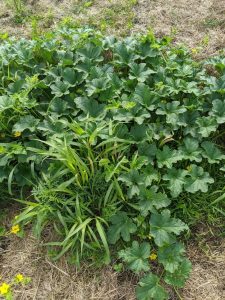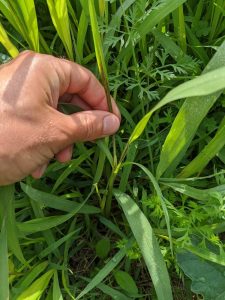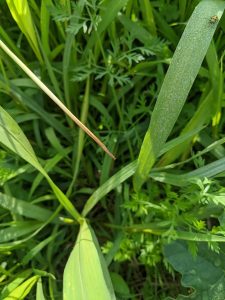If they have not already, your early season residual herbicides will soon run out of steam. Depending on the crop and production system, you may soon lose the ability to cultivate row middles. Now what? For many vegetable crops, managing emerged weeds is difficult with few postemergence herbicide options. This article will focus on cucurbit crops, but many of the principles translate to other crops as well.
General Guidelines:
Do not rely solely on postemergence options: I know hindsight is 20/20, but if you have more escaped weeds than you’d like this year, now is the time to start evaluating changes for next season. With most crops, a weed control program that relies entirely on managing weeds after they’ve emerged is a formula for failure. Consider combining postemergence herbicides with other management tactics including stale seedbed, plastic mulch, mechanical cultivation, cover crops, or residual (AKA soil-applied) herbicides. Always “start clean”.
Aim small: As with all other postemergence herbicide applications, target small weeds less than 4” tall. Larger weeds require higher herbicide rates, which can increase the risk of crop injury. Larger weeds are also more difficult to control.
Keep an eye on pre-harvest intervals: In order to avoid exceeding the allowable amount of pesticide residue, allow enough time between herbicide application and harvest. For example, the pre-harvest interval for clethodim (ie Select®) products is 14 days for all cucurbit crops. However, the pre-harvest interval for sethoxydim (ie Poast®) is 14 days for squash, pumpkin, and watermelon, but only 3 days for cantaloupe and cucumbers.
Crop oil concentrate (COC) vs non-ionic surfactants (NIS): Most postemergence herbicides will benefit from the addition of a crop oil concentrate or non-ionic surfactant. Consult the herbicide label to make sure the product you are using does not already contain COC or NIS. Both NIS and COC achieve the same objective of helping the herbicide get into the targeted weeds (and crop) although they work in different ways. While NIS’s simply reduce surface tension and allow spray droplets to spread over more of the leaf surface area, COC’s actually degrade some of the wax on the leaf surface to assist increased uptake.
In general, under “normal” conditions either is fine. However, under conditions of elevated temperature or plant stress, NIS typically results in less foliar burn than COC (Figure 1.). Both types of products are sold under various names and formulations. Consult the product labels for information specific to your NIS or COC. Although many NIS and COC labels will provide a range of rates, I don’t see much advantage of including more than 0.25% NIS (1 quart NIS per 100 gallons of solution) or 1% COC (1 gallon COC per 100 gallons of solution).
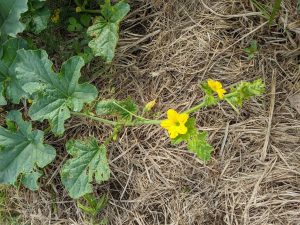
Figure 1. Foliar burn and chlorosis (yellowing) on a cantaloupe plant from an application of clethodim plus 0.25% non-ionic surfactant.
Herbicide Options:
Row middles: If your vines have not grown into the row middles, a directed or hooded application can be made with broad-spectrum herbicides glyphosate (ie Roundup®) or carfentrazone (ie Aim®) (Figure 2). Avoid contacting the crop, which could result in crop injury or crop death. Halosulfuron (ie Sandea®) can also be applied as a post-directed application to row middles in summer squash (30*), gourd (30), watermelon (57), pumpkins (30), winter squash (30), cucumber (14), cantaloupe (57), honeydew (57), and crenshaw melons (57). While glyphosate will control both broadleaves and grasses, halosulfuron and carfentrazone offer little grass control. *Required days between application and harvest.
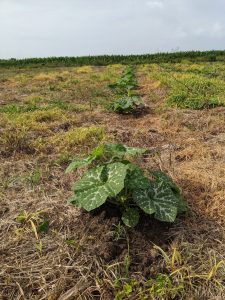
Figure 2. Glyphosate applied POST-directed between rows of no-till pumpkins prior to vine-running. Note the weed escapes in the row.
Grasses: Use clethodim or sethoxydim following the product label rate based on weed size and species.
Broadleaves: Halosulfuron (ie Sandea®) is really the only postemergence broadleaf product labeled for over-the-top use across cucurbit crops. In Midwestern states the label states that Sandea can only be applied over-the-top to bare ground cucumbers, cantaloupes, honeydews, crenshaw melons. The production system (bareground vs plasticulture) is not specified on the label for pumpkins and winter squash. Applications should target seeded or transplanted cucurbits beginning at the 3-5 true leaf stage and prior to the appearance of female flowers. Postemergence applications of Sandea may result in yellowing and stunting of the crop which may result in delayed crop development. Halosulfuron also has activity on yellow nutsedge.
Be patient: Systemic herbicides take longer to work than contact herbicides. For example, when using grass-selective herbicides, it may take two weeks or more for grassy weeds to die. Several days following the application of a grass-selective herbicide you should notice slowed grass growth, stunting, and/or chlorosis (yellowing) or reddening of leaf tissues (Figure 3). To confirm the herbicide is working you can pull the newest leaf from the plant (Figure 4). You should notice water-soaked or necrotic tissue near the base of the leaf (Figure 5).
